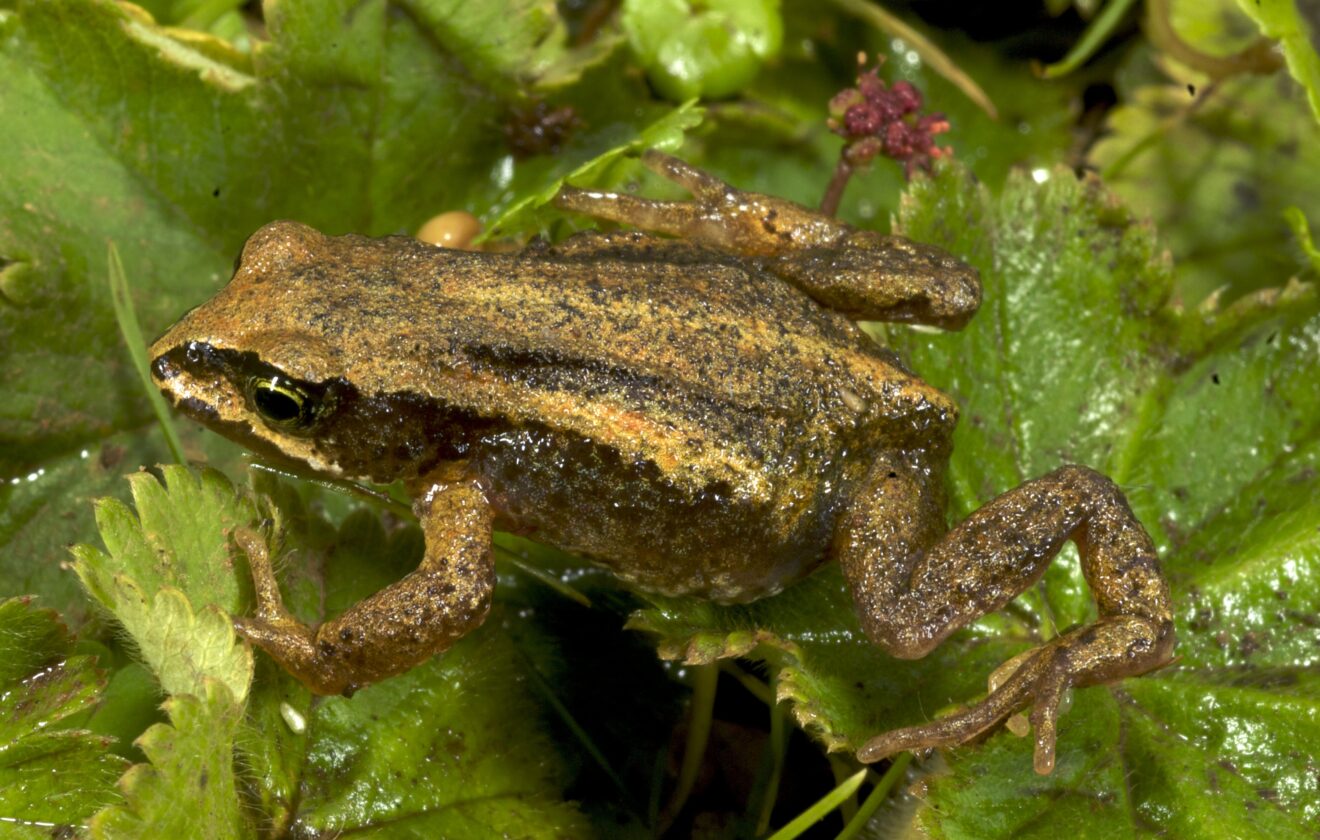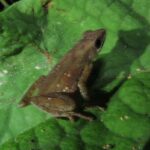- Exploring Altiphrynoides malcolmi: Ethiopia's Enigmatic Highlands Frog
- Taxonomy and Classification of Altiphrynoides malcolmi
- A Delicate Dance with Altitude: Natural Habitat
- The Frog Cloaked in Mist: Physical Characteristics
- A Life Beneath the Mist: Behavior and Life Cycle
- The Web Connecting Life: Ecological Importance
- The Fragile Future of Altiphrynoides malcolmi: Conservation and Threats
- Cultural and Scientific Significance: A Deeper Connection
- Conclusion: Protecting the Jewel of Ethiopia’s Highlands
Exploring Altiphrynoides malcolmi: Ethiopia’s Enigmatic Highlands Frog#
Imagine venturing up into the lush, mist-shrouded highlands of Ethiopia, navigating through a mosaic of evergreen forests, alpine moorlands, and marshy wetlands. Here, in habitats often cloaked in gentle fog and cool mountain rains, dwells a creature as intriguing as it is elusive—the Altiphrynoides malcolmi. Known to science enthusiasts as Malcolm’s Ethiopian Toad, this small but remarkable amphibian embodies the exquisite biodiversity and ecological richness hidden within Ethiopia’s mountainous landscapes.
Scientifically named Altiphrynoides malcolmi, this unique frog offers an exciting glimpse into evolutionary adaptation, specialized ecology, and conservation biology. But beyond its scientific interest lies a captivating tale of survival amid Ethiopia’s steep plateaus and fragile ecosystems.
Taxonomy and Classification of Altiphrynoides malcolmi#
Malcolm’s Ethiopian Toad belongs to the family Bufonidae, widely recognized as the true toads. Within this family, the genus Altiphrynoides is notably distinctive, comprising specialized “high-altitude” toads adapted to Ethiopia’s rugged montane ecosystems.
Scientifically described in 2005 by Tandy and colleagues, Altiphrynoides malcolmi was named in honor of Malcolm Largen, a herpetologist whose extensive research significantly enriched our understanding of Ethiopian amphibians. This species shares its genus with just one other known toad, Altiphrynoides osgoodi. Both have evolved unique characteristics, shaped by their specialized mountainous habitats, which distinctly set them apart even from closely related toads found in Africa’s warmer lowlands.
A Delicate Dance with Altitude: Natural Habitat#
Heeding the whispers of altitude and moisture, Malcolm’s Ethiopian Toad thrives almost exclusively within Ethiopia’s Bale Mountains and surrounding highlands. These regions represent one of Ethiopia’s most significant biodiversity hotspots, brimming with endemic wildlife and unique ecological niches.
At elevations typically ranging from 3,000 to 4,000 meters above sea level, habitats are lush, often cold, blanketed by a shifting mist and abundant rainfall. Here, dense stands of wild heather, fragile grasslands, and sphagnum-rich peat bogs dominate the landscape. Such environments uniquely suit the delicate amphibian physiology of A. malcolmi, offering not only rich feeding opportunities but also safety from predators.
This frog carefully selects damp microhabitats sheltered beneath vegetation, often hiding among moss-covered rocks and waterlogged soil. The moisture-rich microclimate provides precisely the conditions these amphibians need, given their permeable, sensitive skin and their dependence on moisture for respiration and reproduction.
The Frog Cloaked in Mist: Physical Characteristics#
Small yet unmistakably enchanting, Altiphrynoides malcolmi rarely exceeds three centimeters in size, making it one of the more demure residents of the Ethiopian highlands. Their bodies are compact, well-adapted to a secretive existence beneath damp cover—a camouflage strategy perfected over millions of years of evolutionary fine-tuning.
Coloration varies subtly, but generally embraces hues of olive, greyish browns, and deep greens, imitating the lush mosses and vegetation of their surroundings. Their skin showcases a series of irregular patches, spots, and subtle stripes—every individual uniquely patterned as if touched by the gentle brushstrokes of nature.
Adaptations extend beyond aesthetics; their relatively long hind limbs facilitate rapid and strong leaps, vital for evading small predators and quickly retreating beneath vegetation. The pronounced tubercles and granulated textures covering their bodies enhance camouflage, further masking them in their alpine homes and protecting them from predatory birds or small mammals scanning from above.
A Life Beneath the Mist: Behavior and Life Cycle#
Altiphrynoides malcolmi navigates life with perfect synchrony to the rhythmic pulses of seasonal rains and temperature fluctuations characteristic of Ethiopia’s highlands. Predominantly nocturnal in habit, dusk announces their emergence—a low chorus resonating softly, echoing through the misty air as individuals venture out to forage.
Feeding Habits and Foraging Behavior#
Like most amphibians, Malcolm’s Ethiopian Toad hunts primarily insects and small arthropods that thrive within its marshy habitats. As twilight descends upon their alpine home, these toads become active, employing acute senses and sensitive toes to detect vibrations from tiny prey. A combination of stealthy approach and lightning-quick reactions ensure successful forage sessions even under cover of darkness.
The Intriguing Reproductive Rituals of A. malcolmi#
The breeding cycle corresponds with the highlands’ rainy seasons, usually between April and October, when persistent moisture transforms the landscape into an amphibian paradise. Males vocalize earnestly from hidden perches near shallow pools, orchestrating a chorus that, though soft and understated, carries deeply resonant melodies through the mountain air.
Uniquely among many African amphibians, Altiphrynoides malcolmi displays intriguing reproductive strategies, often laying eggs carefully onto damp vegetation or mossy substrates. This meticulous choice offers protection from desiccation, predators, and fungal diseases. Following careful nurturing by the rainy climate and protective vegetative cover, small tadpoles hatch into ephemeral pockets of standing water, transforming gradually into miniature adults over several weeks.
The Web Connecting Life: Ecological Importance#
Though subtle and inconspicuous, A. malcolmi occupies a pivotal ecological niche within Ethiopia’s unique mountain ecosystems. Amphibians such as this species are classic examples of indicator species—sensitive monitors whose presence, absence, or abundance gives ecologists valuable insights into environmental health.
As predators of numerous insects and arthropods, these small toads contribute significantly to controlling pest populations, regulating insect diversity and abundance. Simultaneously, they form important prey items for birds and mammals, fitting neatly into the delicate food webs and nutrient cycles of Ethiopian highland ecosystems.
The Fragile Future of Altiphrynoides malcolmi: Conservation and Threats#
Despite their vital ecological role, Altiphrynoides malcolmi faces formidable threats. The International Union for Conservation of Nature (IUCN) categorizes this species as Endangered, with declining population trends primarily attributed to human-mediated disruptions.
Diminished habitat quality presents the most pervasive threat. Agricultural expansion, grazing pressure from livestock, and habitat fragmentation have steadily eroded the pristine habitats crucial for this frog’s survival. Additionally, climate change, bringing unpredictable rainfall patterns and warmer average temperatures, poses a significant, albeit less immediately visible, threat. Since these amphibians rely on stable, moisture-rich environments, even slight alterations in climate can negatively influence breeding success, growth rates, and survival.
Fortunately, dedicated conservation efforts are underway. Protected areas established in the Bale Mountains and surrounding highlands help shield crucial habitats from development and degradation. Local and international conservation groups collaborate frequently, fostering sustainable land-use practices and raising awareness about amphibian conservation among local communities.
Cultural and Scientific Significance: A Deeper Connection#
Beyond ecological roles, Altiphrynoides malcolmi holds invaluable cultural and scientific symbolism. Its existence and ecological interactions deepen our understanding of evolutionary adaptation and biodiversity, offering essential insights into mountainous ecosystems’ resilience and vulnerability. Scientifically, this species’ physiology and life cycle adaptations inspire valuable research, informing conservation strategies for vulnerable mountain habitats worldwide.
While perhaps less visible than charismatic megafauna, Malcolm’s Ethiopian Toad symbolizes Ethiopia’s valuable natural heritage and encourages a mindful reconsideration of biodiversity protection efforts that encompass all contributing species, great and small alike.
Conclusion: Protecting the Jewel of Ethiopia’s Highlands#
From its discreet nighttime calls beneath mist-drenched valleys to its delicate patterns camouflaged against the mossy undergrowth, Altiphrynoides malcolmi epitomizes Ethiopia’s precious biodiversity. This frog represents an intricate ecological narrative woven over millennia, shaped by its mountainous home and evolving alongside a landscape vulnerable to human pressures and climate change.
Now more than ever, heightened understanding and support for conservation efforts become critical. Every action counts—from sustainable community practices to raising global awareness about mountainous biodiversity. Together, we must protect this humble amphibian, preserve Ethiopia’s high-altitude ecosystems, and maintain a lighter human touch upon the natural world, ensuring the gentle, enigmatic Malcolm’s Ethiopian Toad continues its quiet symphony beneath Ethiopian highland stars.








